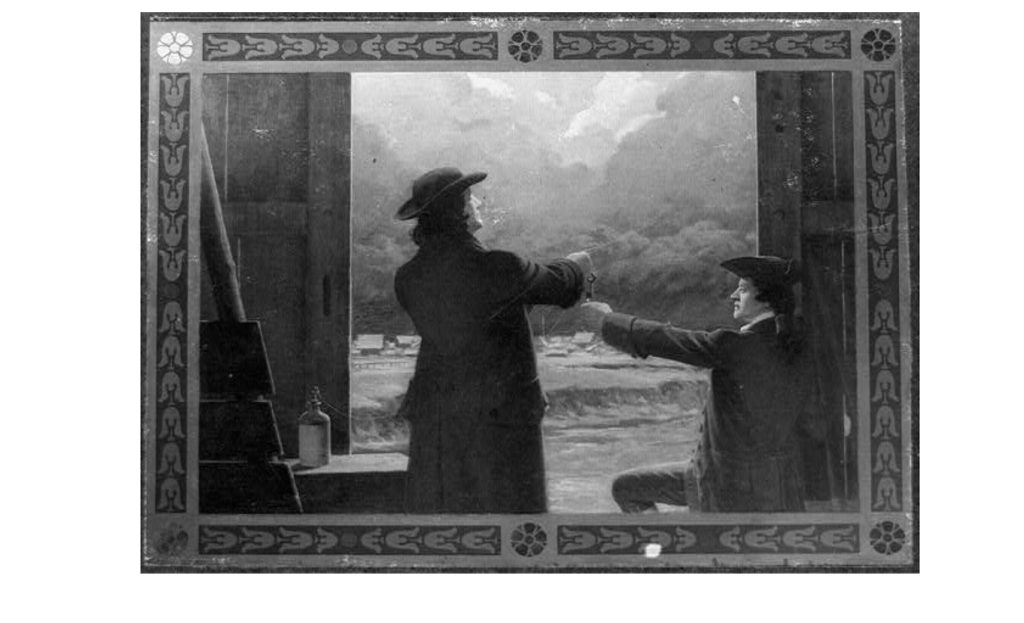
Artist: Charles E. Mills (American, 1856-1956)
U.S. Library of Congress, Digital Id#cph 3b42841
On 10 Jun 1752 Benjamin Franklin conducted an experiment on electricity that has become both famous and legendary. Electricity was already understood by this time, and many were studying static electricity. What Franklin was studying was the connection between lightning and electricity. Originally, he wanted to do the experiment on a church spire but decided using a kite would be better. As a thunderstorm began to develop over Philadelphia, he and his son William headed out to a field with a kite to conduct the experiment.
The Experiment
Contrary to popular belief, the experiment itself was conducted without lightning striking the kite. According to the Franklin Institute, he constructed a kite and attached a wire at the top to act as a lightning rod. The bottom of the kite used hemp string, which when wetted with rain, would be an excellent conductor for an electrical charge. And then he attached silk string that he would hold the kite from the doorway of a shed. With his son’s help, they got the kite aloft and just waited to see what would happen during the storm.
Then just as they were about to give up, Franklin noticed the loose strands of hemp were standing erect. Moving his finger near the metal key they had attached; he felt the electricity. He and his son using a Leyden jar collected the static electricity they would discharge later. It was a significant achievement and added more to the study of understanding and using electricity. He wrote of the experiment to the Pennsylvania Gazette (19 October 1752) and how to recreate it. Also, he was not the first to do this type of experiment. One had been done a month earlier in France by Thomas-François Dalibard. A year later Georg Wilhelm Richmann attempted to do the same thing in St. Petersburg. Unfortunately, he was struck by ball lightning, which is very rare and to this day baffles scientists and died.
Aftermath
Franklin went on to invent the lightning rod, which over time became widespread in use for homes and buildings. The electrical charge from a lightning strike would pass harmlessly through the rod and cables keeping it safely away from any conductive material. Airplanes utilize them as well since they often have to fly near or around storms where lightning is present. Ships use them as well and the charge is dispersed into the water. Franklin would receive the Copley Award from the Royal Society for his experiments.
Needless to say, many doubt the experiment happened but one has to bear in mind whether the doubters read his own words of how it was done or simply accepted the common fable he stood outside in the rain waiting for lightning. Mythbusters actually tried to do the second one, which is to have lightning strike the kite. And they found it would likely be fatal to do that and that if Franklin really did do it, he was very lucky to have survived. What happened to Richmann is often cited to show how fatal it could be as well. Except Richmann was struck by ball lightning, a very rare occurrence that is not wholly understood. And Franklin was clear lightning never struck the kite and that what he was trying to do was see if lightning generated electricity in the air, which it did. Others either misread or, for reasons of their own perhaps in jest, said Franklin stood out in the rain and flew a kite to get struck by lightning. And it got into the public consciousness where it became considered true after a while. It is not the first, and likely not the last, where an event gets retold and later key facts get lost and the wrong story takes hold instead.
Sources
Ameyers. “Benjamin Franklin and the Kite Experiment.” The Franklin Institute, 19 Oct. 2023, fi.edu/en/science-and-education/benjamin-franklin/kite-key-experiment.
—. “Benjamin Franklin Flies Kite During Thunderstorm.” HISTORY, 6 June 2024, www.history.com/this-day-in-history/franklin-flies-kite-during-thunderstorm.
Ben Franklin’s Contribution to Our Understanding of Electricity. www.ushistory.org/franklin//science/electricity.htm.
Suggested Reading
Brands, H. W. The First American: The Life and Times of Benjamin Franklin. Anchor, 2002.
The Autobiography of Benjamin Franklin: The Original 1793 Edition. Independently published, 2022.
Franklin, Benjamin. Benjamin Franklin’s Book of Virtues. Books of American Wisdom, 2016.
Titanic News Channel is a participant in the Amazon Services LLC Associates Program, an affiliate advertising program designed to provide a means for sites to earn advertising fees by advertising and linking to Amazon.com.
